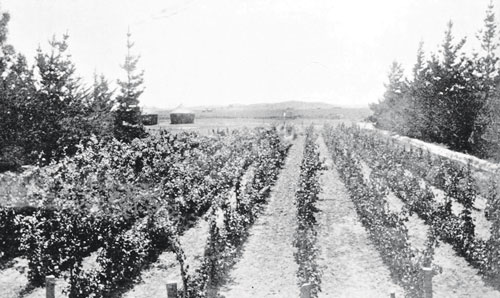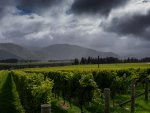Auntsfield Estate, owned by the Cowley family, is the site of the region’s very first vineyard. It was planted back in 1873 by a Scottish émigré named David Herd, exactly 100 years before Montana arrived on the local scene.
While the vineyard continued to produce wine for 52 years, the vines were finally removed in 1931 and the land was returned to other farming practices.
By the time Graeme and Linda Cowley bought the property in the 1990’s it was surrounded by sheep and stock farms – not a vine in sight. In fact the Cowley’s had no idea of its historical importance to Marlborough at the time of purchase. It didn’t take long though before the couple discovered that the property had been known as Auntsfield, that there was an underground cellar on site (albeit one that had been turned into a dumping ground) and that the property had been home to Marlborough’s very first wines, made by former owner David Herd himself.
So began a painstaking journey into the past. Descendants of Herd were tracked down, stories began to emerge of the vineyard and winery with a bottle of wine from the year Herd died in 1905, uncovered.
The Cowley’s, realised they had stumbled on to something very precious. With one son Ben as viticulturist, the other Luc as winemaker, the “new look” Auntsfield was born.
It might have been enough to restore the in ground dirt floor cellar and bring David Herd’s name back into the lexicon of Marlborough’s wine history, but the Cowley’s wanted more than that. They wanted to recreate history. So much so, that they began scrolling through the history books to gain a better understanding of Herd’s winemaking forays. What were the vines he first planted, how were they planted and what style of wine did he make from them?
Vines first. The wine was written about in medical journals (for its medicinal benefits) and also won a number of medals at shows in Australia and New Zealand and it appeared the variety was a form of Muscat. Muscat Petits Grains, to be more accurate.
Ben says knowing that Herd had stopped off in Victoria, Australia on his way to New Zealand, where Muscat had a huge following, they decided that must have been his inspiration.
A search of New Zealand’s vine records showed that Romeo Bragato had begun collecting cuttings from all the original vines that arrived in New Zealand in the 1870’s, 80’s and 90’s. These had made up a government collection at Te Kauwhata, (later transferred to Rakaia). Graeme was determined to find out if there were any original sources of Muscat available in New Zealand, and discovered cuttings from the very first Muscat vines were still in existence in Rakaia. DNA testing was undertaken to confirm the vines were true to variety, and four clippings of Petits Grains Muscat were provided to Auntsfield to allow them to propagate. The only problem being, the cuttings were heavily virused and needed to be kept well away from any other vines on the property. Once they had grown enough for further propagation Riversun took over, taking clippings and heat treating them, before taking tissue cultures to create new virus free cuttings. These were then grafted onto phylloxera free rootstock and potted up.
The entire process, from the initial searches through to the potted vines arriving back in Marlborough took over 10 years. Patience was very much a key attribute.
During one of the many historical searches, Graeme came across an old aerial photo of the property that showed the outline of the original vineyard.
“We were able to overlay that with our mapping software and see just where each vine had been planted,” Ben says.
Given there was no such thing as treated pine round posts, galvanized wire or plastic clips in Herd’s day, the Cowley’s began collecting manuka posts, and searching for non galvanised number eight wire on surrounding properties. Their aim was to recreate the vineyard exactly as Herd would have developed it.
The end result is a tiny plot of 400 vines, held up by manuka poles, weaving their way through number eight wire, with strainer posts that actually come from the Meadowbank Station boundary fence, which Herd helped oversee the building of back in the 1870’s.
“Each vine is planted in exactly the same place that David Herd planted them,” Ben explains.
“We also had David Herd’s great grandson, Felix Herd (who was in his 90’s) plant the first vines, Graeme elaborates.
While the family was certain Herd wanted to replicate the Rutherglen style of Muscat he had encountered in Victoria, Ben quickly realised that the Petits Grains Muscat they were growing, was unlikely to be capable of that.
“Originally we were trying to get the fruit as ripe as we possibly could to replicate that Rutherglen style. (There the fruit can reach 28 – 32 brix). What we found though is that it got to 24 or 25 brix and that’s where it stopped, it wouldn’t go any further.
“That’s just how the vines have responded in a much cooler climate than where it is normally grown in say Australia or southern France.
“Over there it is known for small berries and tight clusters. Here though they have been quite large berries and open clusters. And the vines are in an early part of their life, so they are quite virile.”
Viticulturally the Petits Grains Muscat is an early budder and can be an early ripener, although it can be left to hang for some time. Given it is an unknown variety in Marlborough Ben says he is learning as he goes, although there is a sense of the past always sitting on his shoulder.
“As you pick those grapes, they will be exactly the same as they were when David Herd picked his grapes. It’s the same bit of dirt, the same vines, grown in exactly the same place. And other than the variation we have in climate, season-to-season, they are exactly the same. So in effect we are going through exactly what he went through 140 years ago.”
While the vines were planted in late 2010, this year was the first harvest. For winemaker Luc, it was as much of a learning curve as the growing of it had been for Ben.
“It has been a journey into the unknown,” he admits.

The original David Herd Vineyard.
Producing 600 litres of juice, he says the fruit was pressed in a similar way to any other white variety. But fermentation was where it all began to change tact. Given Herd was as unlikely as the Cowley’s to get the brix level higher than 25, Luc came to the conclusion he would have had to make a fortified wine.
“He probably made a style similar to what we are trying to make, which is a bit more of a Beaumes De Venise, which is made in the south of the Rhone.
“What you do is different from normal winemaking. You stop the ferment at 100 grams of RS (residual sugar) and the way you stop it is by adding alcohol. So the wines end up with an alcohol level a little over 15 percent and quite a lot of RS.
“We wanted to make a style that reflected Marlborough and the Muscat variety as well. A Beaumes De Venise is a style that is very aromatic and shows that Muscat character very nicely.”
But don’t expect to see any of the wine for sale this year. Luc says instead they are continuing their trials, with the majority of the juice being distilled for future vintages.
“We have tried a few different styles. We made a dry style and we left some juice for future blending. But the majority of the 600 litres of wine from the vineyard this year we distilled into spirits, which we will be able to use from the 2016 vintage onwards. So the brandy we will use to fortify it will be from the original vineyard and from that original clone.
“It’s amazing what we got from the spirits we distilled. It’s incredibly aromatic, with orange blossom and bright citrus aromas, which are so characteristic of the Muscat variety. It is going to be an interesting end wine.”
None will be barrel fermented he says, instead the wine is likely to be blended in future years and spend a considerable time in bottle before being sold.
And while the quantities will be extremely small, the interest aspect of the end product, let alone the historical significance, will be immense.















